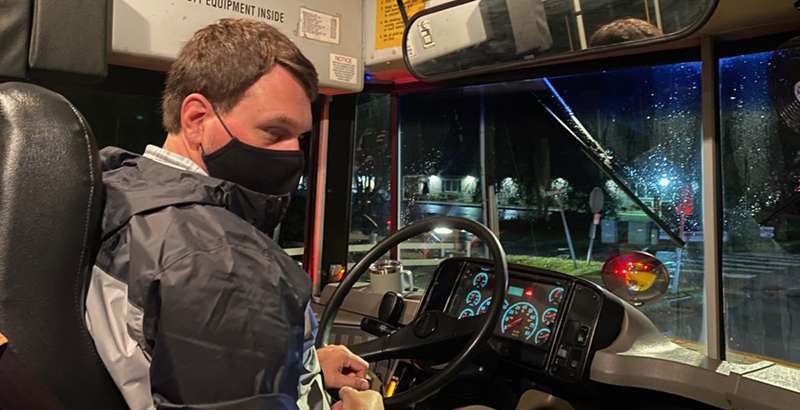COVID Chaos Leaves Districts With Bus Driver Shortage

Get stories like this delivered straight to your inbox. Sign up for The 74 Newsletter
Guilford County Schools was dealing with a bus driver shortage long before COVID-19 hit in 2020. But since the pandemic began, district leaders have been particularly cognizant of the need to monitor their transportation resources.
Superintendent Sharon Contreras says her district monitors data on both teacher and bus driver absences multiple times throughout the day and evening now. But even so, it’s hard to know the situation for the next day of school until late at night.
So, last Thursday night, as the driver absence numbers rolled in, Contreras realized there was a problem. The district already had a large number of bus driver vacancies. Those combined with the absences anticipated for the next day put the district in a dire position.
“We realized we wouldn’t be able to provide transportation … for all students,” she said. “But we knew it was too late to do that to parents or to students.”
Contreras decided that school would have to start late the next day to accommodate the absences and vacancies. The district delayed middle schools by one hour and high schools by 90 minutes. The stopgap worked, and the district was able to get everyone to school. But over the next two weeks, Contreras said the situation is going to get worse.
The Omicron surge
The new year brought a surge in a new COVID-19 variant: Omicron. North Carolina is breaking records in daily totals for infections, and illness is hitting those who are unvaccinated particularly hard. Unfortunately, Contreras said that district data indicates bus drivers are the employee group with the lowest vaccination rate.
“We know that makes them more susceptible to contracting COVID, as well as experiencing more symptoms for a longer amount of time,” she said.
Late last week and this weekend, the district was trying to figure out what it could do to ensure transportation is available for all its students.
Here is what that’s going to look like: For the next two weeks, some Guilford students who go to high schools in the cities of High Point or Greensboro will not be able to ride the traditional yellow school bus. Instead, the district has worked out a partnership with the public transportation systems for the two cities that will let those students ride for free on city buses.
This will allow the district bus drivers to provide transportation for elementary and middle school students, as well as for high school students outside the cities where there isn’t any public transportation. Traditional busing will also be available to students in the cities who are given transportation as part of their Individualized Education Plans (IEP).
Contreras said the district is asking parents to drive their kids to school if at all possible to lessen the demand on district resources.
A larger problem?
Guilford — the third largest school district in the state — is not the only one in North Carolina having this problem.
WRAL reported that on Friday, the Wake County Public School System had more than 150 bus drivers out because of COVID-19 and more than 100 routes had to be canceled. Wake is the largest school district in North Carolina.
In the second largest district in the state, Charlotte-Mecklenburg Schools (CMS), bus routes were operating on 15 to 30 minute delays on average last week, according to Leanne Winner, executive director for the state School Boards Association. Some routes were having to be combined or doubled-up on to deal with driver vacancies, and other district employees with commercial driver’s licenses (CDL) were pitching in to help students get to school, Winner said.
State Superintendent of Public Instruction Catherine Truitt said her son’s middle school bus didn’t have a driver one day last week. He is a Wake County Public School student. Her husband was home and could take him to school, she said, but one of her son’s friends wasn’t so lucky. He rides a different bus, which also was without a driver one day last week. He had to walk to school.
Truitt said that when the state Department of Public Instruction surveyed districts in the fall, they found a great deal of variation in bus driver shortages around the state. Districts that required other kinds of non-certified staff — teacher assistant, front office staff — to cover bus routes fared better. But not all districts do that.
Truitt said she remembers when she was a teacher in Johnston County years ago getting called in to drive a bus wasn’t a popular assignment.
“I think districts probably need to be real careful in their policies because they don’t want non-certified staff to quit because they’re having to drive a bus,” she said.
Nevertheless, the driver situation has been bad enough at times that even DPI staff are pitching in. Jeremy Gibbs is DPI’s regional director of support services for the Western part of the state. Truitt said that in the fall when Transylvania County was having bus driver issues, Gibbs signed up to drive a bus and still does so every morning.
“These kinds of shortages I hope make people appreciate their children’s bus drivers,” Truitt said.
Exacerbating factors
The bus driver shortages is made worse, in part, by wage issues.
The WRAL article reports that bus drivers protested low wages in Wake County back in November by calling out of work sick. The Board of Education there approved a one-time bonus to try to deal with that situation. Meanwhile, the Durham County Board of Education raised the minimum wage for drivers to $17 an hour in September, according to WRAL. Back in October, CMS raised its starting pay for bus drivers to $17.75 an hour to help deal with roughly 140 vacancies a day, according to this Spectrum News article.
The North Carolina General Assembly raised the minimum wage for bus drivers and other non-certified public school employees in the state in its long session budget. They will be paid $13 an hour this year and $15 an hour next year from the state. Districts can supplement with local dollars, but not every district can afford to. For those who can’t, they’re stuck with what the state can provide.
Katherine Joyce, executive director of the North Carolina Association of School Administrators, said that $13 an hour isn’t cutting it and is exacerbating the current bus driver shortage.
“It’s still not competitive with pay that our bus drivers could see in fast food jobs,” Joyce said.
What’s to be done
While there are long-term issues impacting the bus driver shortage, the immediate crisis is the result of COVID-19 and the Omicron surge. And that’s not an issue limited to North Carolina.
Back in September, the Massachusetts’ governor called in the National Guard to help get students to school. Contreras said that might be a good idea, but so would deploying smaller passenger vehicles that don’t require a CDL license to drive. That way, more district staff could help with transportation. She said she also asked her legislative delegation to file an emergency bill that would offer extra pay to administrators in her district willing to get a CDL license and pick up a route before and after school.
She pointed out that the state’s rainy-day fund has billions of dollars in it. And she said the current situation is well beyond ordinary precipitation. She called it “a tsunami.”
“If increasing the pay for bus drivers will allow us to work, we need to do that immediately,” she said.
Of course, some of these solutions take time, and for Guilford County and other beleaguered districts, the problem is right now.
“I wish there was a way to expedite the relief that’s needed for our school districts in getting bus drivers and other personnel,” Joyce said. “I think where we are is really just needing to get the COVID surge under control.”
Fortunately, the situation isn’t as dire in all of the state’s other 115 school districts. Winner said she is hearing from most district leaders that the bus driver shortage hasn’t reached the level of severity being seen in Guilford, Wake, or CMS yet. But that doesn’t mean it won’t.
“It is definitely something to watch,” she said. “There are other districts who could get there, but they’re just not there yet.”
This article first appeared on EducationNC and is republished here under a Creative Commons license.
Get stories like these delivered straight to your inbox. Sign up for The 74 Newsletter

;)